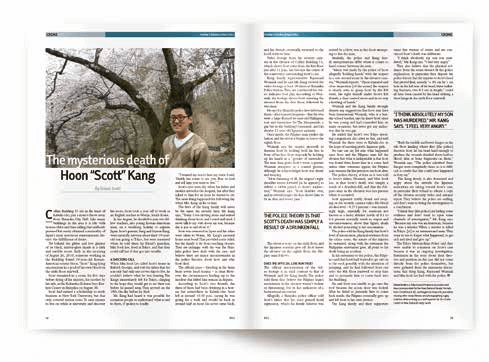Issue:

A TWO YEAR OLD SEARCH FOR ANSWERS PROVES FRUSTRATING FOR A FAMILY DEALING WITH RELUCTANT AUTHORITIES
After two long years of relentlessly pressuring the Japanese authorities to release key documentation and evidence relating to the death of their son, the family of Korean American tourist Hoon “Scott” Kang finally managed to obtain a copy of his autopsy report from the office of the Tokyo public prosecutor.
Kang, who worked as an English teacher in South Korea, died while holidaying in Tokyo in the summer of 2010 after sustaining severe head injuries in a building in Kabukicho. (A story about the strange circumstances of his death, and the unhappiness of his family with the police investigation appeared in the March, 2011 issue of Number 1 Shimbun.)
The 19 year old was found lying unconscious in a pool of his own blood in the early hours of Aug. 26, in the stair well of a highrise of small hostess bars and clubs near Shinjuku City Hall. He remained in a coma for five days before dying of his injuries on Aug. 30.
Scott’s father, Sung Kang, requested a copy of his son’s autopsy when he met with Shinjuku Police in late 2010. Yet it wasn’t until late 2012, after retaining a Japanese lawyer, that they were finally able to obtain a copy of the autopsy.
The family remains disappointed and angry because the information is far from complete. “It leaves off crime scene photos, autopsy photos, the video of Scott being assaulted in the elevator and the outdoor security video footage,” says family spokesman Ray Wozniak.
Wozniak says the family had planned to have the autopsy independently analyzed by a local medical examiner in the United States, but without the photos it is proving very difficult for a third party to make a judgment about how Scott died.
The Kang family believes some of the conclusions reached by the doctor who performed the autopsy, Koichi Uemura of Tokyo Medical and Dental University, are not sound.
The autopsy report states: “The cause of death is believed to be swelling of the brain due to fracture of the cranium and acute subdural hematoma caused by a blow to the left rear of the head. “The fractures to the cranium are thought to be injuries sustained by a blow from a blunt object with a broad surface.”
The Kang family dispute Uemura’s conclusion, which supports the police position that his death was accidental. Says Wozniak, “It is apparent to anyone with a grasp of science that a hole knocked in Scott's head with such force as to drive the bone fragment up into his skull resulted from a blow with a pointed instrument.
Yet without further evidence, such as the autopsy photos, it is difficult for the Kang family to prove these suspicions.
Dr. Hirotaro Iwase, an independent forensic pathologist from Chiba University School of Medicine, who carried out an independent analysis of the autopsy report after it was released to the family, was unable to draw any clear conclusions about how Scott died from the autopsy report alone, other than that he died from “blunt force trauma.”
“With regards to the manner of death suicide, accident or homicide I don’t know, says Iwase. “Or whether his death was related to a crime or not.” He adds that, in his opinion, there is nothing specific about Scott’s injuries that point to a clear cause of death.
But he acknowledges that the refusal of the Japanese authorities to release the photos places significant limitations on his ability to carry out an independent analysis.
According to Iwase, this reluctance on the part of the authorities to fully disclose autopsy information to the next of kin of the deceased is common practice in Japan, though it goes against international norms, especially in cases such as Kang’s, where the official cause of death has been determined to be an accident.
“The police refusing to release the autopsy in the case of criminal investigations is normal in most countries,” he says. “But when a crime hasn’t occurred, the autopsy is usually released fairly promptly. Not in Japan.”
In fact, the two year period which the Kang family has had to wait before getting access to their son’s autopsy report is actually not long by Japanese standards. Many families are forced to wait much longer and in many cases the authorities outright refuse to release the autopsy.
“It is common in Japan for the authorities to wait years and years before releasing an autopsy, if they do at all,” Iwase says. He believes the autopsy issue is symptomatic of a wider problem in Japanese police culture that he calls “overly secretive. The police don’t want the public to know the manner in which they carry out investigations.”
The Shinjuku Police Department and Professor Koichi Uemura, who performed the autopsy on Hoon Kang, declined to comment for this story.
Simon Scott is a freelance journalist and Japan correspondent for the New Zealand Herald. He contributes to The Sunday Age, The Japan Times, the Korea JoongAng Daily and others. He thanks James Benson for translating the autopsy report.

